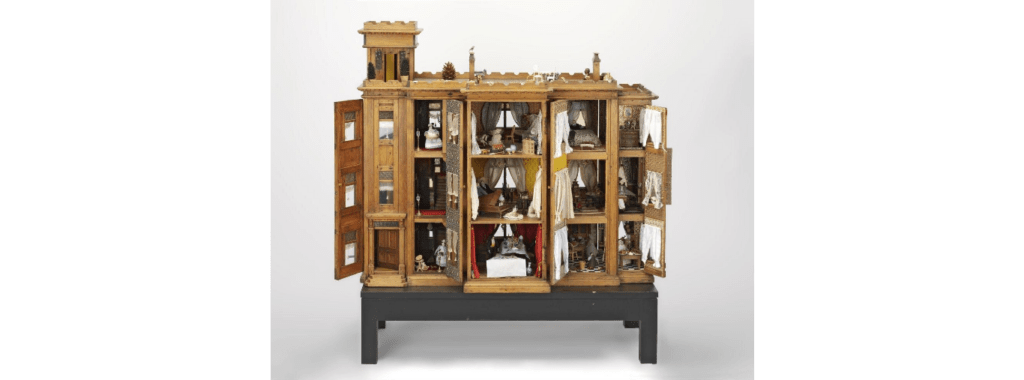I used to love playing with my grandma’s dolls’ house so much that my grandpa built me one. That little blue house was my most cherished possession for years and I would play with it for hours on end. Many a friend who visited remembers how proud I was of it and how adamant I was that nobody else was to play with it because I had it set up just so. That dolls’ house was my sanctuary and I would not have it disturbed.
Perhaps that affinity with the particular kind of escapism that dolls’ houses can bring is why the Bettiscombe Dolls’ House is one of my favourite artefacts.
I discovered Bettiscombe when reading an article in The Guardian about a V&A exhibition on dolls’ house history. The house was made in 1870 with multiple opening panels to allow access to the rooms inside and, rather unusually, is fitted with a roof garden and a functioning lift, operated via a small lever. However, it was not the visual or technical elements of the house that I loved so much, but the story of one of its owners.
Textile designer Betty Pinney bought the house from a friend for £5 in 1962 and decided to dedicate her life to refurbishing it. Her daughter, Susanna, states her mother’s aim was to try to recreate some of her childhood in miniature with the additional storyline of the house being inhabited by “a family who had worked abroad for the Empire” (V&A, Bettiscombe, 2021) to allow her breathing room to make the interior more interesting. She was an accomplished seamstress so she furnished much of the house herself by making a good deal of the furniture and fittings while other additions were gifts from friends.
Betty was meticulous in her creation as can be seen in the detailed instructions that the V&A acquired from Betty to a local craftsman regarding the dolls. These specify that “the butler should have a paunch and the footman calves to his legs” (Oliver Wainwright, The Guardian, 2014).
Betty’s intense attention to detail is perhaps unsurprising when we consider her daughter’s words on why her mother was so focused on the dolls’ house. Betty, she said, was “a perfectionist, and, because she could not achieve perfection in real life, she bought a doll’s house” (Oliver Wainwright, The Guardian, 2014). This is a sentiment that resonates deeply with me.
As is clear from my friends’ recollections about how particular I was about how my dolls’ house I think it’s fairly clear that I too am a perfectionist. My anxiety means that I like to control things and I want everything to be just right, but, as Betty knew all too well, we don’t always get perfection.
Dolls’ houses are an outlet for that where we have control, and we can create an image of a perfect life even if we can’t live one. I may have never truly appreciated how much this toy from my girlhood helped me to feel more in control in a world that often felt far from perfect without finding this artefact and hearing Betty’s story. It’s nice to know that I’m not alone and that when I feel out of control it’s a good excuse to buy a dolls’ house.
-Molly Ashmeade
Junior Girl
Girl Museum Inc.

